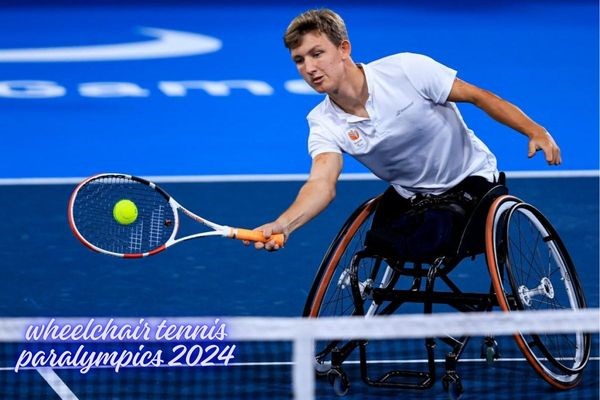Introduction: wheelchair tennis paralympics 2024
Wheelchair tennis has become one of the most exciting sports in the Paralympic Games, combining raw athletic power with clever strategy. At the 2024 Summer Paralympics in Paris, the event drew massive attention from fans worldwide. It wasn’t just about who won medals — it was about inspiring performances, personal journeys, and the joy of competing at the highest level.
This article takes you through the heart of wheelchair tennis at Paris 2024 — from the rules and competition format to remarkable athletes, their hobbies, and the uplifting moments that made this year’s tournament unforgettable.
Table of Contents
Understanding Wheelchair Tennis
While it shares many similarities with standard tennis, wheelchair tennis has its own unique rhythm and set of rules. Players use specially built sports wheelchairs to glide across the court, performing sharp turns and quick accelerations with remarkable precision.
Key Differences from Traditional Tennis
- Two-Bounce Rule – Players may allow the ball to bounce twice before returning it, with the second bounce permitted outside the court lines.
- Specialized Chairs – These lightweight wheelchairs are angled for balance and maneuverability, helping players react quickly to shots.
- Accessibility – The sport welcomes athletes with different physical impairments, making it one of the most inclusive events in the Paralympics.
Wheelchair Tennis at Paris 2024
The wheelchair tennis matches at Paris 2024 were staged at the iconic Roland Garros Stadium, a venue already famous for hosting the French Open. The Paralympics ran from August 28 to September 8, and the energy in the arena was electric.
Competition Categories
The tournament featured several categories to ensure fair competition:
- Men’s Singles
- Women’s Singles
- Men’s Doubles
- Women’s Doubles
- Quad Singles (for athletes with impairment in at least three limbs)
- Quad Doubles
Each category brought its own share of drama, skill, and unforgettable moments.
Standout Matches and Performances
Paris 2024 offered plenty of memorable matches that kept fans glued to their seats.
Men’s Singles
The men’s final was a tactical battle between experienced champions and new talents. Long rallies, smart serves, and well-timed volleys made for an intense showdown.
Women’s Singles
In the women’s final, the match stretched for nearly three hours, testing the players’ stamina and mental strength. Each rally was a fight for control, with precision and patience proving just as important as power.
Quad Division
The quad category brought some of the most creative rallies of the tournament. Players in this division demonstrated a blend of quick decision-making and extraordinary control over the ball.
Stars of the 2024 Paralympics
Several athletes left a mark with their performances and personalities:
- Diede de Groot (Netherlands) – Continued her dominance in women’s singles with unmatched skill.
- Shingo Kunieda (Japan) – A respected veteran known for his tactical mind and calm approach.
- Niels Vink (Netherlands) – Quad division star with lightning-fast reactions.
- Kamnissh Yadav (India) – An emerging name with a fearless, attacking style.
How Paralympic Athletes Prepare
Wheelchair tennis players dedicate years to building the strength, agility, and mental focus needed for success.
Core Elements of Training
- Strength Workouts – Building upper body power for serves and strokes.
- Wheelchair Skills – Practicing rapid changes in direction and short bursts of speed.
- Shot Drills – Working on precision, spin, and placement.
- Mental Conditioning – Staying composed during high-pressure points.
Hobbies and Life Beyond the Court
Away from competition, these athletes lead rich and interesting lives, often with hobbies that help them relax and recharge.
Popular Hobbies Among Wheelchair Tennis Players
- Music – From playing instruments to enjoying concerts.
- Cooking – Experimenting with healthy recipes and regional dishes.
- Travel – Exploring new cultures during international tournaments.
- Reading – Diving into novels or motivational books.
- Gaming and Photography – Enjoyed by players like Niels Vink.
For instance, Diede de Groot has shared her love for cooking, while others take every chance to sightsee during their travels.
The Emotional Side of the Sport
Beyond athletic skill, wheelchair tennis thrives on emotional moments — from players lifting their arms in victory to heartfelt embraces after a hard-fought match.
Sportsmanship
Win or lose, most matches end with players shaking hands and exchanging words of respect.
Fan Support
Crowds at Roland Garros were loud, supportive, and enthusiastic, cheering for every incredible shot. Social media buzzed with hashtags like #WheelchairTennis and #Paris2024 during the games.
Stories That Inspire
Many Paralympic wheelchair tennis players have overcome personal hardships to reach the top level.
- Recovering from Injury – Some first discovered the sport during rehabilitation.
- Balancing Multiple Roles – Many juggle education, work, and family while training.
These stories highlight the determination and resilience that define Paralympic competition.
Technology That Boosts Performance
Modern wheelchair tennis benefits from advanced sports technology, which has evolved significantly in recent years.
Innovations at Paris 2024
- Carbon-Fiber Wheelchairs – Light, strong, and designed for speed.
- Custom Seating – Improves posture and reduces fatigue.
- Data Analysis Tools – Tracks player movements and match stats to refine strategies.
The Team Behind the Players
While athletes are the ones on the court, their success depends on a strong support network.
Essential Roles
- Coaches – Fine-tuning game plans and techniques.
- Physiotherapists – Preventing and treating injuries.
- Sports Psychologists – Helping athletes stay confident and focused.
- Family & Friends – Offering encouragement every step of the way.
Why Wheelchair Tennis Matters
Wheelchair tennis at the Paralympics is more than a competition — it’s a global platform that challenges stereotypes and celebrates human ability.
Beyond the Court
- Encourages people with disabilities to take up sports.
- Shifts the conversation from limitations to possibilities.
- Inspires young athletes to dream big.
Fun and Lesser-Known Facts
- The sport debuted at the Paralympics in 1992.
- Serves in wheelchair tennis can exceed 150 km/h.
- Many players compete in both Paralympic and International Tennis Federation (ITF) events.
Looking Ahead to 2028
With growing interest and investment, wheelchair tennis is set to become even bigger by the Los Angeles 2028 Paralympics. Expect faster play, more media coverage, and new talents emerging on the global stage.
Final Thoughts
The Wheelchair Tennis event at the Paris 2024 Paralympics was a celebration of determination, skill, and passion. From the fierce rallies to the friendships off the court, it showcased why this sport captures so many hearts.
For the athletes, it’s about more than just chasing medals — it’s about inspiring others, breaking barriers, and proving that with dedication, the possibilities are limitless.



